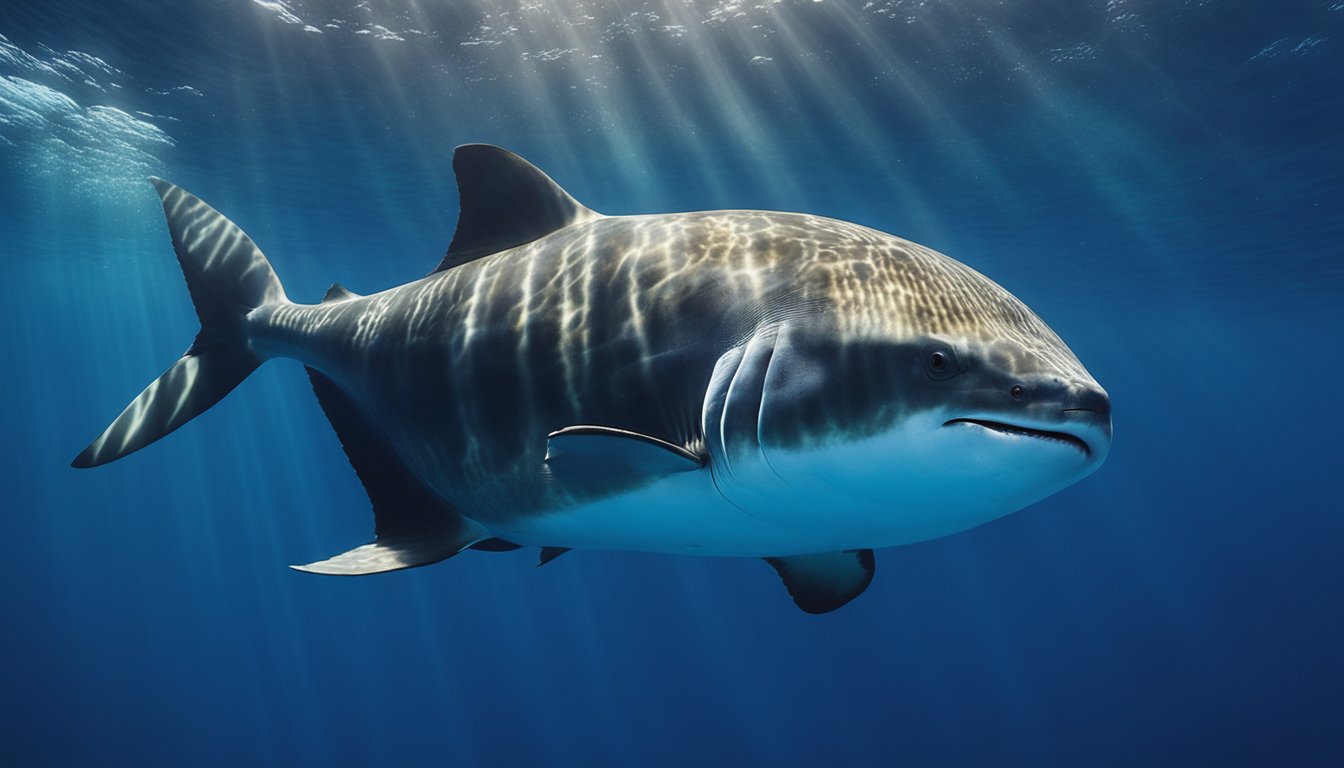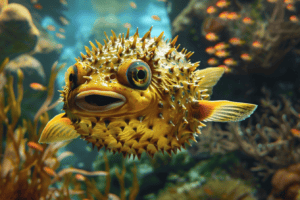The ocean is a vast world full of mysteries and wonders waiting to be explored.
Among the many creatures that inhabit the ocean’s depths, the majestic sunfish, also known as Mola Mola, stands out for its unique appearance and fascinating behavior.
Sailing the oceans to encounter these impressive creatures is an unforgettable experience that leaves a lasting impression on those lucky enough to witness it.

The sunfish is a massive fish that can grow up to 10 feet in length and weigh over 2,000 pounds, making it one of the heaviest bony fish in the world.
Its body is flattened and shaped like a disk, with a distinctive round shape that gives it the appearance of a giant floating head.
Despite its size, the sunfish is a gentle creature that feeds mainly on jellyfish and other small marine animals.
Sailing the oceans to observe sunfish in their natural habitat is a unique opportunity to witness their impressive size and graceful movements.
Sunfish are known for their curious behavior and their tendency to approach boats, making it possible to observe them up close.
However, it’s important to remember that sunfish are a protected species, and it’s crucial to respect their space and avoid any actions that could harm them.
Exploring the Mola Mola
Defining the Sunfish
The Mola Mola, also known as the ocean sunfish, is a fascinating creature that belongs to the family Molidae.
It is the heaviest bony fish in the world, with an average weight of 1,000 kg and can grow up to 3.3 meters in length.
The sunfish has a unique appearance, with a flattened body and a round shape, which makes it look like a giant floating head.
The sunfish’s body is covered with a thick layer of mucus, which protects it from parasites and predators.
Its skin is dark gray or brown and is often covered in scars, caused by parasites or bites from other sea creatures.
The sunfish has a small mouth and no visible teeth, but it feeds on a variety of prey, including jellyfish, squid, and small fish.
Habitat and Distribution
The sunfish can be found in all the world’s oceans, but it prefers warm waters.
It is often seen near the surface of the water, basking in the sun to regulate its body temperature.
The sunfish is a migratory species, and its movements are influenced by ocean currents and water temperatures.
The sunfish is a solitary creature, and it spends most of its time swimming alone.
However, during the breeding season, it can be seen in groups of up to 30 individuals.
The sunfish lays millions of eggs, which are released into the water column. The eggs hatch into tiny larvae, which grow into juvenile sunfish.
In conclusion, the Mola Mola is a fascinating creature that has captured the imagination of many people.
Its unique appearance and behavior make it a popular subject for marine biologists and ocean enthusiasts.
Despite its massive size, the sunfish is a gentle giant that poses no threat to humans.
Life Cycle and Behavior

Reproduction Journey
The majestic sunfish, also known as Mola Mola, has a unique reproductive journey.
Female sunfish can produce up to 300 million eggs at once, making them the fish with the highest number of eggs in the world.
However, only a few of these eggs will survive to adulthood. Once the eggs are fertilized, they develop into larvae, which then transform into juveniles.
The juveniles grow rapidly, reaching up to 60 cm in just a few months.
Interestingly, the male sunfish has a unique reproductive organ called a “clasper,” which is used to transfer sperm to the female during mating.
The male sunfish is much smaller than the female, and it is not uncommon for a female to mate with multiple males during a single breeding season.
Dietary Habits
The sunfish is a unique creature when it comes to its dietary habits.
Despite its massive size, it feeds mainly on small organisms such as jellyfish, plankton, and small crustaceans.
The sunfish is known for its slow metabolism and can go without food for long periods.
The sunfish’s diet also includes parasites that attach themselves to its skin.
The sunfish will often breach the surface of the water to dislodge these parasites by rubbing against rocks or other objects.
This behavior is known as “sunfish basking.”
In conclusion, the life cycle and behavior of the sunfish are fascinating and unique.
With their massive size, unique reproductive journey, and unusual dietary habits, it’s no wonder that these creatures have captured the imagination of scientists and nature enthusiasts alike.
Human Interactions

The majestic sunfish, also known as Mola Mola, is a fascinating creature that has captured the attention of humans for centuries.
Despite being a popular sight for sailors and divers, human interactions with sunfish have been a mixed bag of positives and negatives.
Conservation Efforts
Sunfish populations have been threatened by overfishing, pollution, and habitat destruction.
However, conservation efforts have been put in place to protect these gentle giants.
The International Union for Conservation of Nature (IUCN) has listed the sunfish as vulnerable, and several countries have implemented regulations to protect them.
In some areas, fishing for sunfish is prohibited, and in others, the use of drift nets, which can entangle and harm sunfish, is banned.
Cultural Significance
Sunfish hold cultural significance in many parts of the world.
In Japan, sunfish are considered a delicacy, and their meat is used in traditional dishes such as sunfish sashimi.
In some cultures, sunfish are believed to have healing properties and are used in traditional medicine.
Sunfish also feature in folklore and mythology, with stories of these massive creatures inspiring awe and wonder.
Despite their cultural significance, it’s important to remember that sunfish are living creatures that deserve respect and protection.
By learning about and appreciating these incredible animals, we can work towards ensuring their survival for generations to come.
Frequently Asked Questions

What do ocean sunfish typically eat in their natural habitat?
Ocean sunfish, or Mola mola, are known to have a varied diet that includes jellyfish, small fish, squid, and crustaceans.
They also feed on plankton, which they filter from the water using their gill rakers.
Interestingly, they have been observed eating their own shed skin and feces, which may provide them with additional nutrients.
Can you tell me how big a Mola mola can get?
Mola mola is the heaviest bony fish in the world and can grow up to 11 feet (3.3 meters) in length and weigh as much as 5,000 pounds (2,268 kilograms).
Their unique shape, which resembles a giant head with a tail, makes them one of the most recognizable fish in the ocean.
Why are sunfish considered unique compared to other marine species?
Sunfish are unique in many ways, including their flattened, disc-like shape, which allows them to maneuver through the water with ease.
They also lack a tail fin, which is replaced by a large, fan-like structure called a clavus.
Additionally, they have a unique reproductive strategy, where females can lay up to 300 million eggs at once, making them one of the most prolific egg-laying fish in the ocean.
Are ocean sunfish endangered, and what are their population trends?
Ocean sunfish are not currently considered endangered, but their population trends are not well understood.
They are often caught as bycatch in fishing nets, which can lead to accidental deaths.
Additionally, they are vulnerable to pollution, habitat loss, and climate change, which could impact their populations in the future.
What are some of the most fascinating facts about the Mola mola?
Mola mola has many interesting features, including its ability to produce up to 300 million eggs at once, its unique shape, and its ability to generate heat through its muscles, which allows it to survive in cold waters.
They are also known for their love of basking in the sun, often seen floating near the surface with their fins out of the water.
How do ocean sunfish maintain their buoyancy in the water?
Sunfish have a unique method of maintaining their buoyancy in the water.
They lack a swim bladder, which is a common feature in most fish that helps them control their buoyancy.
Instead, sunfish rely on their large, oily liver, which helps them stay afloat by regulating their density in the water.
Additionally, they have a unique skeletal structure that allows them to store large amounts of water, which can help them maintain their buoyancy.









